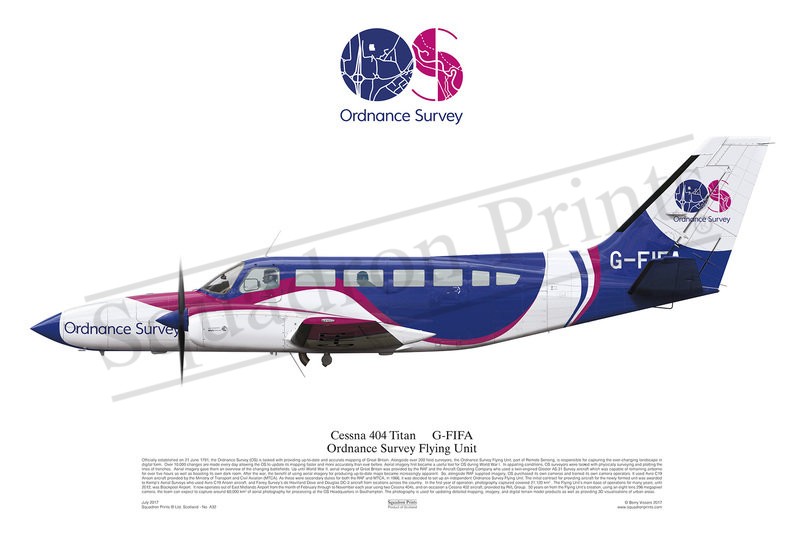#A32 Cessna 404 Titan

Description
Squadron Prints Lithograph No. A32 - G-FIFA, Cessna 404 Titan, Ordnance Survey Flying Unit.
Officially established on 21 June 1791, the Ordnance Survey (OS) is tasked with providing up-to-date and accurate mapping of Great Britain. Alongside over 200 field surveyors, the Ordnance Survey Flying Unit, part of Remote Sensing, is responsible for capturing the ever-changing landscape in digital form. Over 10,000 changes are made every day allowing the OS to update its mapping faster and more accurately than ever before. Aerial imagery first became a useful tool for OS during World War I. In appalling conditions, OS surveyors were tasked with physically surveying and plotting the lines of trenches. Aerial imagery gave them an overview of the changing battlefields. Up until World War II, aerial imagery of Great Britain was provided by the RAF and the Aircraft Operating Company who used a twin-engined Gloster AS.31 Survey aircraft which was capable of remaining airborne for over five hours as well as boasting its own dark room. After the war, the benefit of using aerial imagery for producing up-to-date maps became increasingly apparent. So, alongside RAF supplied imagery, OS purchased its own cameras and trained its own camera operators. It used Avro C19 Anson aircraft provided by the Ministry of Transport and Civil Aviation (MTCA). As these were secondary duties for both the RAF and MTCA, in 1966, it was decided to set up an independent Ordnance Survey Flying Unit. The initial contract for providing aircraft for the newly formed unit was awarded to Kemp’s Aerial Surveys who used Avro C19 Anson aircraft, and Fairey Survey’s de Havilland Dove and Douglas DC-3 aircraft from locations across the country. In the first year of operation, photography captured covered 21,120 km² . The Flying Unit’s main base of operations for many years, until 2012, was Blackpool Airport. It now operates out of East Midlands Airport from the month of February through to November each year using two Cessna 404s, and on occasion a Cessna 402 aircraft, provided by RVL Group. 50 years on from the Flying Unit’s creation, using an eight lens 296 megapixel camera, the team can expect to capture around 60,000 km² of aerial photography for processing at the OS Headquarters in Southampton. The photography is used for updating detailed mapping, imagery, and digital terrain model products as well as providing 3D visualisations of urban areas.
